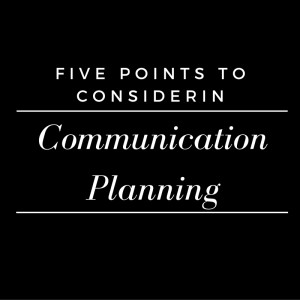Almost every business I spend time with says they have communication issues. Usually their communication concerns are for many different reasons. There could be internal competition between  divisions and leaders marking their territory, no connection between staff and management, exclusiveness and secrecy, bad leadership or bad employees, and maybe just an overall lack of a communication approach. That got me thinking about communications in business and the execution of a new plan.
divisions and leaders marking their territory, no connection between staff and management, exclusiveness and secrecy, bad leadership or bad employees, and maybe just an overall lack of a communication approach. That got me thinking about communications in business and the execution of a new plan.
Gilbert Amelio said, “Developing excellent communication skills is absolutely essential to effective leadership. The leader must be able to share knowledge and ideas to transmit a sense of urgency and enthusiasm to others. If a leader can’t get a message across clearly and motivate others to act on it, then having a message doesn’t even matter.”
So what does this have to do with the strategic planning and your organization? At some point you are going to need to implement and make change in your organization. The very nature of planning is to realize a new strategic vision through effective implementation (transformation) and operationalization. Therefore, you need to communicate to create.
I decided for this blog to take a page right from my book S.E.T. for Success, Chapter 16 on Communication Plan and Map mostly to provide some insight and definition around communications planning.
Here are 5 points, taken from my book, to consider in communication planning.
Communication Planning
Communication planning is an important part of ensuring that the correct message is delivered and that your people are fully engaged. It’s an integral part of having work done through people. How can you expect your people to act on the strategic and tactical plans unless they know what is on the strategic agenda? If your people don’t know, they can’t act on the plans. As a result, your business will be less likely to succeed in the execution of its strategic initiatives and tactical plans. To be successful, make sure you create, and implement a communication plan.
Give the People what they Want
Interestingly, what management thinks motivates people and what employees say is rarely the same thing. Management tends to think wages and job security are the most important factors for people, but many employees prefer inclusion, involvement, and to be appreciated for their work. This sentiment might vary depending on the working generation being reviewed, but in general people want communication. They want you to have a conversation with them, not to merely tell them what’s going on and what to do. Given a lack of communication, people will invent their own ideas. As a business leader, it’s important that you take the lead and make sure you’re providing the right amount and right level of communication for your people.
Create a Communication Map
As part of the strategic planning process, the planning team needs to discuss communications from both an internal and external perspective. They need to also make sure the message is consistent. In today’s world of click-of-a-button information and communication dissemination, there’s no leeway for inconsistent messaging. We no longer have the luxury of writing complex communication plans. Nowadays a communication map must have the message and all channels of communication represented in a single view. This could be a 11 x 17 inch sheet of paper.
Focus on the Audience
Today it’s especially important to know your audience, especially considering all the possible communication channels and mediums available and the specific needs of each target audience and sub-audience. Your strategic plan’s communication map should make the distinction between the internal and external stakeholders, as well as establish a connection with your stakeholders based on their communication needs.
Items to Consider
There are many items to be considered when you’re looking at your communication plan and the development of a communication map. Identifying and finding the best way to communicate with your audience will be the key to your successful implementation of your plans. The communication planning process is similar to the overall planning approach—you’ll still need to consider your stakeholders’ wants and needs. You’ll also need to find the appropriate vehicle to communicate the overall goals and objectives, the plans features, benefits and values, and find a way to address your stakeholders’ questions.
A Final Thought
We all need a communication plan in our business. It’s the last piece of the planning puzzle. It is part of the planning and analysis cycle from the beginning to the end. More importantly, it’s part of the implementation and transition process that ensures your plans get successfully implemented. Not only that, with a proper communication plan you can address the question of your preferred business culture and start making moves towards people engagement and getting the results you desire. But it starts with outlining a communication approach.









